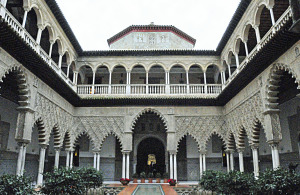When Christian forces of the Reconquista recaptured Seville in 1248, they took as their palace an Islamic fortress along the Guadalquivir River. In 1364, Peter I, King of Castile and León, began building a new palace on the site. Peter called upon the Muslim architects and builders who had recently created the palace at the Alhambra in Granada, then still under Islamic control. The design style used in Peter’s palace, incorporating richly carved walls, pointed arches and other traditional Islamic details, came to be known as Mudéjar and was popular throughout southern Spain. Writings on palace walls praised both God and Allah.
The best-known quarter of Peter’s palace is the Courtyard of the Maidens. Its name reportedly suggested a false rumor, fueling the Reconquista, that Muslim rulers of Iberia demanded 100 virgins each year from the Christian cities under their control. A narrow reflecting pool in the center of the courtyard was flanked by sunken gardens, evoking Islamic images of the gardens of Paradise. The same theme was later used in the reflecting pool of the Taj Mahal. Scalloped arches supported on columns surrounded the open courtyard, another defining characteristic of Mudéjar style.
Peter I’s rivals called him “Peter the Cruel” for executing leaders of an anti-Jewish riot. He was beheaded in 1369 by his half-brother Henry, who derided him as “King of the Jews” for opposing persecution of Spanish Jews.
King Peter’s successors added buildings and gardens to the Real Alcázar. The second floor of Peter’s palace is used by the Spanish royal family when in Seville. The Courtyard of the Maidens, its reflecting pool covered, masquerades as the twelfth century palace of the King of Jerusalem in the movie “The Kingdom of Heaven.” And history now regards Peter I as “Peter the Just” for repudiating, albeit cruelly, religious bigotry.

Comments are closed.